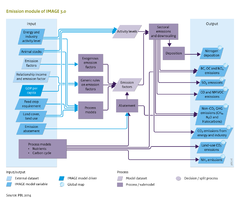Emissions/Description: Difference between revisions
Jump to navigation
Jump to search
No edit summary |
No edit summary |
||
| Line 47: | Line 47: | ||
* Combinations of the methods described above for a specific period, followed by additional rules based on income levels. | * Combinations of the methods described above for a specific period, followed by additional rules based on income levels. | ||
In IMAGE, EKC is used as an empirically observed trend, as it offers a coherent framework to describe overall trends in emissions in an Integrated Assessment context. However , it is accepted that many driving forces other than income influence future emissions. For instance, more densely populated regions are likely to have more stringent air quality standards. Moreover, technologies developed in high-income regions often tend to spread within a few years to developing regions. The generic equations in IMAGE can capture this by decreasing the threshold values over time. For CO2 and other greenhouse gases, such as halogenated gases for which there is no evidence of EKC behaviour, IMAGE uses an explicit description of fuel use and deforestation. | In IMAGE, {{abbrTemplate|EKC}} is used as an empirically observed trend, as it offers a coherent framework to describe overall trends in emissions in an Integrated Assessment context. However , it is accepted that many driving forces other than income influence future emissions. For instance, more densely populated regions are likely to have more stringent air quality standards. Moreover, technologies developed in high-income regions often tend to spread within a few years to developing regions. The generic equations in IMAGE can capture this by decreasing the threshold values over time. For CO2 and other greenhouse gases, such as halogenated gases for which there is no evidence of {{abbrTemplate|EKC}} behaviour, IMAGE uses an explicit description of fuel use and deforestation. | ||
The methodology for EKC scenario development applied in the energy model is based on two types of variables: income thresholds (2–3 steps); and gas- and sector-dependent reduction targets for these income levels. The income thresholds are set to historical points: the average OECD income at which air pollution control policies were introduced in these countries; and current income level in OECD countries. The model assumes that emission factors will start to decline in developing countries, when they reach the first income threshold, reflecting more efficient and cleaner technology. It also assumes that when developing countries reach the second income threshold, the emission factors will be equal to the average level in OECD regions. Beyond this income level, the model assumes further reductions, slowly converging to the minimum emission factor in OECD regions by 2030, according to projections made by IIASA under current legislation (current abatement plans). The IMAGE rules act at the level of regions, this could be seen as a limitation, but as international agreements lead countries to act as a group, this may not be an important limitation. | |||
The methodology for EKC scenario development applied in the energy model is based on two types of variables: income thresholds (2–3 steps); and gas- and sector-dependent reduction targets for these income levels. The income thresholds are set to historical points: the average {{abbrTemplate|OECD}} income at which air pollution control policies were introduced in these countries; and current income level in OECD countries. The model assumes that emission factors will start to decline in developing countries, when they reach the first income threshold, reflecting more efficient and cleaner technology. It also assumes that when developing countries reach the second income threshold, the emission factors will be equal to the average level in OECD regions. Beyond this income level, the model assumes further reductions, slowly converging to the minimum emission factor in OECD regions by 2030, according to projections made by {{abbrTemplate|IIASA}} under current legislation (current abatement plans). The IMAGE rules act at the level of regions, this could be seen as a limitation, but as international agreements lead countries to act as a group, this may not be an important limitation. | |||
Emissions from industrial processes | Emissions from industrial processes | ||
For the industry sector, the energy model includes three categories: | For the industry sector, the energy model includes three categories: | ||
Revision as of 09:21, 21 May 2014
Parts of Emissions/Description
| Component is implemented in: |
Components:and
|
| Projects/Applications |
| Models/Databases |
| Key publications |
| References |
|
